

We buy, consign and sell antique bottles in our online auction - including old whiskey, bitters, sodas, water,
beers, inks, flasks, spirit, medicine, historical, fruit and pickle jars, utility, barber, gin, Dutch onion, nippers and more!
Your Online Connection to the World of Antique Bottles
800-806-7722 Email: [email protected]
2523 J Street Suite 203, Sacramento, CA 95816
_____________________________________________________________________
HOME BOTTLE SEARCH ENGINE NEW MEMBER REGISTRATION SHIPPING INFO RULES COLLECTING PICTURE GALLERY HISTORY RESOURCES CONSIGNING BOTTLES COLUMN
BOTTLE VALUE CHECKLIST ABOUT AMERICAN BOTTLE AUCTIONS MESSAGE BOTTLE TALK PAST AUCTION CATALOGS UPCOMING BOTTLE SHOWS
_______________________________________________________
History of Glass
In the 1850's, the
West was a bustling, populated area full of rugged and optimistic people from
all over
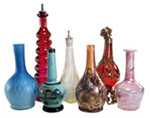 the world. San Francisco was the center of this new world and one of the new
industries that would begin there was the manufacturing of glass bottles. In
1858, Baker & Cutting became the first company to try their hand at producing
glass. In those days, the most important types of containers were for storing
food, and Baker & Cutting decided to make that their priority. They began
producing pickle jars and other types of food jars from their meager San
Francisco glass house. Not long after, Baker left the company, apparently
distraught over the inferior quality glass and little profit. Cutting continued
by himself, although he discontinued producing his own glass and instead ordered
his products outside of California. Because of the poor quality of glass, few of
the Baker & Cutting bottles have survived the ravages of time.
the world. San Francisco was the center of this new world and one of the new
industries that would begin there was the manufacturing of glass bottles. In
1858, Baker & Cutting became the first company to try their hand at producing
glass. In those days, the most important types of containers were for storing
food, and Baker & Cutting decided to make that their priority. They began
producing pickle jars and other types of food jars from their meager San
Francisco glass house. Not long after, Baker left the company, apparently
distraught over the inferior quality glass and little profit. Cutting continued
by himself, although he discontinued producing his own glass and instead ordered
his products outside of California. Because of the poor quality of glass, few of
the Baker & Cutting bottles have survived the ravages of time.
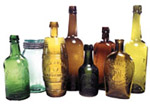 Today, there is only one known example of their work with their name on it
intact. Doubtless, there are other products that they made in circulation, but
they are unmarked and, unless proven otherwise, trade hands as being the product
of another glass house.
Today, there is only one known example of their work with their name on it
intact. Doubtless, there are other products that they made in circulation, but
they are unmarked and, unless proven otherwise, trade hands as being the product
of another glass house.
![]() he
fact that the Baker & Cutting Company made a valiant effort in supplying the
West with glass probably did not go unnoticed by an Eastern glassblower by the
name of Carlton Newman. Bottles were a scarce commodity and pieces were often
shipped from as far away as Honolulu, Tahiti and the Mexican Coast. It was
common for a bottle or jar to have a value which was ten times the value of the
contents. There were companies that specialized in recycling bottles which led
to products being put up with new paper labels placed over embossing for
entirely different products and companies. Before 1862, for a Western company to
have a bottle specifically made for them with their name on it, they would have
to order them from glass companies located in the East. There are some Western
bottles which were made for Western companies which were blown in the East. Many
of these were made by the Union Glass Works in Philadelphia for soda water
companies and, although
he
fact that the Baker & Cutting Company made a valiant effort in supplying the
West with glass probably did not go unnoticed by an Eastern glassblower by the
name of Carlton Newman. Bottles were a scarce commodity and pieces were often
shipped from as far away as Honolulu, Tahiti and the Mexican Coast. It was
common for a bottle or jar to have a value which was ten times the value of the
contents. There were companies that specialized in recycling bottles which led
to products being put up with new paper labels placed over embossing for
entirely different products and companies. Before 1862, for a Western company to
have a bottle specifically made for them with their name on it, they would have
to order them from glass companies located in the East. There are some Western
bottles which were made for Western companies which were blown in the East. Many
of these were made by the Union Glass Works in Philadelphia for soda water
companies and, although
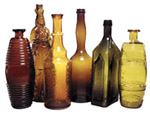 they
aren't of the same pedigree of San Francisco Glass Works glass, can be quite
rare and collectible because of their association with the Gold Rush and the
early development of California. Of course, a company did not need to have
embossing on the bottle to stake their claim on the market. Most of them simply
used a fancy label with their name on it. They would still order bottles from
the East or buy them from a local recycler and then purchase the labels locally.
they
aren't of the same pedigree of San Francisco Glass Works glass, can be quite
rare and collectible because of their association with the Gold Rush and the
early development of California. Of course, a company did not need to have
embossing on the bottle to stake their claim on the market. Most of them simply
used a fancy label with their name on it. They would still order bottles from
the East or buy them from a local recycler and then purchase the labels locally.
![]() n
1862, Carlton Newman founded Pacific Glass Works with Patrick Brennan and
began producing glass the next year at the corner of Iowa and Mariposa Streets
in San Francisco. By 1865 the two glassblowers left Pacific Glass Works to
start their own company, San Francisco Glass Works. In 1868, it burned to the
ground and within two years Newman built a new factory located on King Street
n
1862, Carlton Newman founded Pacific Glass Works with Patrick Brennan and
began producing glass the next year at the corner of Iowa and Mariposa Streets
in San Francisco. By 1865 the two glassblowers left Pacific Glass Works to
start their own company, San Francisco Glass Works. In 1868, it burned to the
ground and within two years Newman built a new factory located on King Street
 near Fourth for production of green, blue and amber glassware. In 1876, San
Francisco Glass Works bought out the stock of the fledgling Pacific Glass
Works and renamed the company San Francisco and Pacific Glass Works (SFPGW)
with Newman serving as president. It was during this time that some of the most
beautiful Western bottles were made. To this day, it is hard to determine which
examples of particular bottles belong to which glass house. There are some
revealing clues however... the most prevalent being the distinctiveness to the
characters, or embossing, on the glass. SFPGW is attributed with having a
particular and consistent curved "R" on bottles that were made by their mold
makers. This trademark identifies the fact that it was not only blown in the
West, but by the SFPGW, makers of the most popular Western bottles collected
today.
near Fourth for production of green, blue and amber glassware. In 1876, San
Francisco Glass Works bought out the stock of the fledgling Pacific Glass
Works and renamed the company San Francisco and Pacific Glass Works (SFPGW)
with Newman serving as president. It was during this time that some of the most
beautiful Western bottles were made. To this day, it is hard to determine which
examples of particular bottles belong to which glass house. There are some
revealing clues however... the most prevalent being the distinctiveness to the
characters, or embossing, on the glass. SFPGW is attributed with having a
particular and consistent curved "R" on bottles that were made by their mold
makers. This trademark identifies the fact that it was not only blown in the
West, but by the SFPGW, makers of the most popular Western bottles collected
today.
![]() mong
bottles blown by both houses and eventually the SFPGW, were soda bottles,
whiskey bottles and flasks, demijohns covered in wicker, medicine bottles, some
inkwells, utility bottles and fruit jars and almost every other type of bottle
you could imagine. Window panes were an exception because of the difficulty of
producing panes. A glass house would specifically have to dedicate
mong
bottles blown by both houses and eventually the SFPGW, were soda bottles,
whiskey bottles and flasks, demijohns covered in wicker, medicine bottles, some
inkwells, utility bottles and fruit jars and almost every other type of bottle
you could imagine. Window panes were an exception because of the difficulty of
producing panes. A glass house would specifically have to dedicate
 its entire operation to that area of production. Newman knew the real value of
his company was in producing bottles for new companies eager to have a bottle
with their own company name on it. In addition to the name of your company, for
a price, you could also choose a special design to be embossed on your bottle,
or even a picture. Animals were popular embossing patterns on bottles made in
the 1870's, including birds, horses, deer and of course, the bear as the mighty
symbol of California . Mold makers spent a great deal of time perfecting their
craft and the varied and detailed designs that remain today are truly a thing of
beauty.
its entire operation to that area of production. Newman knew the real value of
his company was in producing bottles for new companies eager to have a bottle
with their own company name on it. In addition to the name of your company, for
a price, you could also choose a special design to be embossed on your bottle,
or even a picture. Animals were popular embossing patterns on bottles made in
the 1870's, including birds, horses, deer and of course, the bear as the mighty
symbol of California . Mold makers spent a great deal of time perfecting their
craft and the varied and detailed designs that remain today are truly a thing of
beauty.
![]() ottles
desired by collectors of Western glass today are generally broken up into six
categories. They are sodas, whiskeys, bitters, medicines, inkwells and fruit
jars. The value is then broken down into rarity; how many of this particular
bottle are there? Crudity is another very important factor; does it show lots
ottles
desired by collectors of Western glass today are generally broken up into six
categories. They are sodas, whiskeys, bitters, medicines, inkwells and fruit
jars. The value is then broken down into rarity; how many of this particular
bottle are there? Crudity is another very important factor; does it show lots
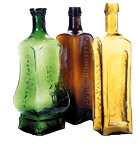 of crudity and bubbles in the glass, is the top uneven? Color is so important.
One example might be worth $100, while the same bottle in a different color
might be worth $1000. Why? Color, color, color. Other factors include an unusual
shape or a misspelling on the bottle. You'd be surprised how many backward "S's"
there are on early Western-made bottles. Age of course, is an important factor
in the desirability of bottles and with bottle making in the West having begun
around 1860, most real important pieces were only produced for about thirty five
years. Most of the truly good bottles from San Francisco, the era in which
collectors might call the Golden Era of Western Glass,
of crudity and bubbles in the glass, is the top uneven? Color is so important.
One example might be worth $100, while the same bottle in a different color
might be worth $1000. Why? Color, color, color. Other factors include an unusual
shape or a misspelling on the bottle. You'd be surprised how many backward "S's"
there are on early Western-made bottles. Age of course, is an important factor
in the desirability of bottles and with bottle making in the West having begun
around 1860, most real important pieces were only produced for about thirty five
years. Most of the truly good bottles from San Francisco, the era in which
collectors might call the Golden Era of Western Glass,
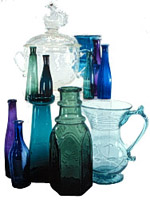 were blown from 1862 to 1889. After 1890, many of the bottles were made using
new glass blowing techniques and equipment. These bottles have tooled tops
instead of hand applied tops and are generally a less crude, more neatly made,
bottles which are less desired by collectors today.
were blown from 1862 to 1889. After 1890, many of the bottles were made using
new glass blowing techniques and equipment. These bottles have tooled tops
instead of hand applied tops and are generally a less crude, more neatly made,
bottles which are less desired by collectors today.
![]() lthough
a majority of the bottles made in San Francisco were made for San Francisco
companies, many bottles were also made for smaller businesses throughout the
West. Prior to 1862, small soda manufacturers in Gold Rush towns like Shasta and
Columbia had bottles made in the East and had them shipped out to them for
distribution of their soda waters. It was a show of status for a company in the
middle of nowhere to have their product in a bottle with their name on it.
Because of the expense of purchasing their custom bottle, however, most of them
probably ended up regretting it. The miners liked to use the soda as a chaser
with their favorite brand of whiskey. Often times, the bubbling water was
flavored and became a favorite for miners and children alike. The bottles were
used over and over
and, for rugged and desolate towns like Shasta. Most of those bottles
didn't survive unbroken. Those that did, are buried in outhouses and dumps long
forgotten. The few examples that survive today are rarely ever seen and when
they are, sell for thousands of dollars.
lthough
a majority of the bottles made in San Francisco were made for San Francisco
companies, many bottles were also made for smaller businesses throughout the
West. Prior to 1862, small soda manufacturers in Gold Rush towns like Shasta and
Columbia had bottles made in the East and had them shipped out to them for
distribution of their soda waters. It was a show of status for a company in the
middle of nowhere to have their product in a bottle with their name on it.
Because of the expense of purchasing their custom bottle, however, most of them
probably ended up regretting it. The miners liked to use the soda as a chaser
with their favorite brand of whiskey. Often times, the bubbling water was
flavored and became a favorite for miners and children alike. The bottles were
used over and over
and, for rugged and desolate towns like Shasta. Most of those bottles
didn't survive unbroken. Those that did, are buried in outhouses and dumps long
forgotten. The few examples that survive today are rarely ever seen and when
they are, sell for thousands of dollars.
_______________________________________
All photographs and editorial copy appearing on this website are the exclusive property of American Bottle Auctions and may not be reprinted, quoted or re-published without the permission of Jeff Wichmann, the owner of American Bottle Auctions.